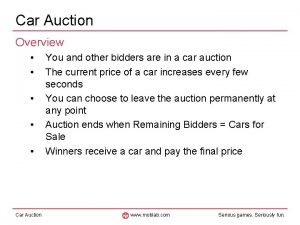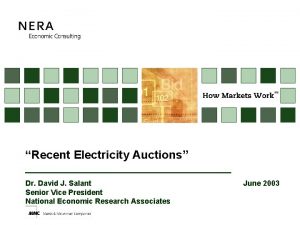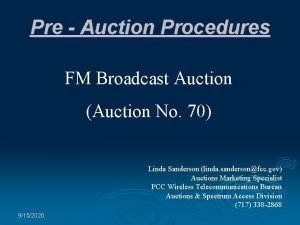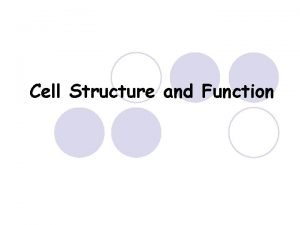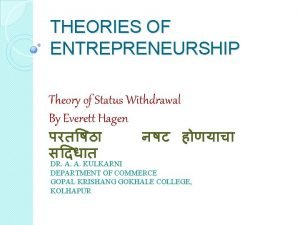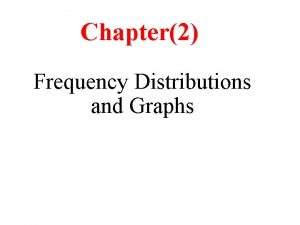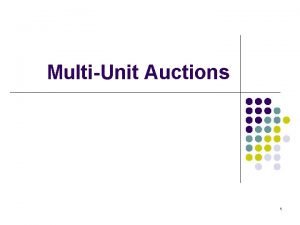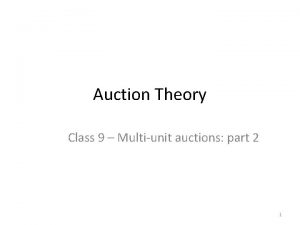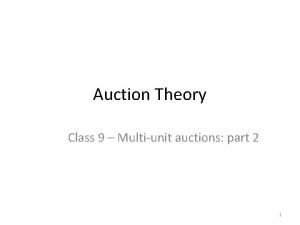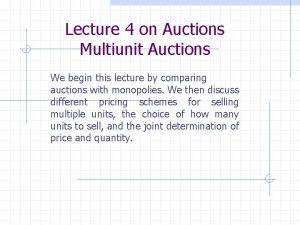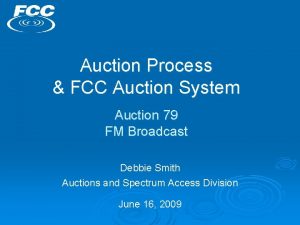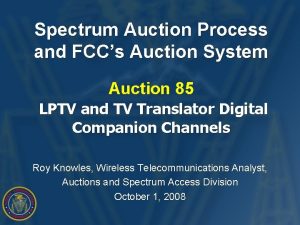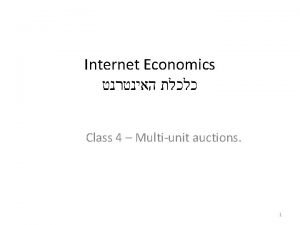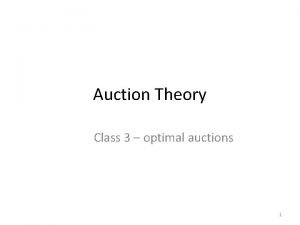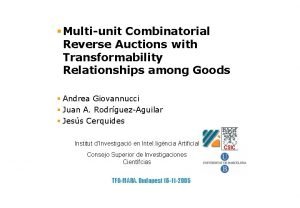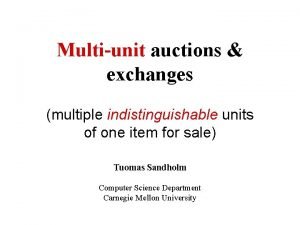Auction Theory Class 8 Multiunit auctions part 1























































- Slides: 55

Auction Theory Class 8 – Multi-unit auctions: part 1 1

Outline • Multi-unit auctions: goals and challenges • Reminder: Walrasian equilibria • The simultaneous ascending auction – – Definition Efficiency incentives Spectrum auction examples • Weaknesses of the Simultaneous Ascending Auction

The art of auction design • Mechanism design with multiple items is not well understood: – – Multi-parameter mechanism design Computational and communication complexity Complex incentive structure Bounded rationality of agents • Still an art, more than science. • But, based on theoretical and empirical knowledge.

Multiple items • Goal: design auctions that allow for multiple kinds of items – Items are non identical. – Also known as “Combinatorial Auctions” • Examples: – Spectrum licenses. – Financial assets. – Transportation of packages. – Advertising campaigns – Industrial equipment. – – Airport landing slots. Bus routes. Internet ads. Privatization

Leading Application: Spectrum Auctions • Adopted by the FCC in 1994. – Revolutionized the sale of spectrum. – Licenses are sold for specific frequencies in specific geographic areas. • Has been used since all over the world. – Also in UK, Germany, Netherlands, Canada, The Pacific, India, etc… • The basis of auctions for complex resource allocation problems. – Trigger for research 5

Combinatorial preferences • Why shouldn’t we auction each item separately? • Auctioning each item alone ignores: – complements: v(TV) + v(VCR) < v(TV+VCR) – Substitutes: v(TV Toshiba) + v(TV Sony) > v(both TVs) • Bidding for packages (or bundles) may increase the efficiency of the auction.

Desired properties • What would be desirable properties of such auctions? – Auction finds “market clearing” prices. – In equilibrium. . . – Auction rules are simple. – Robust to collusion, false-name bids, timing manipulations, etc. – Tractable: ends in reasonable time, bidders can compute their equilibrium strategies. • Bidders should not be expected to process or to report large amounts of data.

Challenges • Sealed-bid auctions? – Problematic. Bidder preferences may be complex. • Market-clearing prices may not exist – Especially when items are complements. • Bidders do not always know their preference… – Determining the preferences is often costly. • Do bidders know the equilibrium strategy in the complex auction?

Computational complexity • The complex structure of multi-item auctions introduces technical problems: – Complexity of winner determination: hard for computers to compute the optimal allocation in a reasonable time • Such computational problems are called NP-hard. • Prevents, for example, the use of VCG in many settings. – Communication complexity: Private values to big to communicate. – Strategic complexity: bidders need to act quickly. Even if they are fully rational, computation (computer/ consultants etc) may be too slow to find the optimal strategy. • Solutions must take other considerations into account (incentive, for example) – Interdisciplinary field.

Outline • Multi-unit auctions: goals and challenges • Reminder: Walrasian equilibria • The simultaneous ascending auction – – Definition Efficiency incentives Spectrum auction examples • Weaknesses of the Simultaneous Ascending Auction

Demand • Bidders observe prices and determine their demand • Per-item prices are announced • Bidder decide what is the bundle that maximizes their surplus under these prices • (we all compute our demand. For example, when going to the supermarket. ) • Formally: For a bidder i, and prices p 1, …, pn we say that the bundle T is a demand of i if for every other bundle S:

Walrasian Equilibrium • We would like to reach an outcome where the market clears. • A Walrasian equilibrium is an allocation S 1, …, Sn and item prices p 1, …, pn such that: – Si is the demand of bidder i under the prices p 1, …, pm – For any item j that is not allocated (not in S 1, …, Sn) we have pj=0

Efficiency of market-clearing prices • The first welfare theorem: The allocation in a Walrasian equilibrium is efficient. • proof: consider another allocation, T 1, …, Tn • For every bidder: • Summing over all bidders: The price of unallocated items is 0 S 1, …, Sn is efficient…

Outline • Multi-unit auctions: goals and challenges • Reminder: Walrasian equilibria • The simultaneous ascending auction – – Definition Efficiency incentives Spectrum auction examples • Weaknesses of the Simultaneous Ascending Auction

Objective • Seller’s goal: maximize efficiency – By law for FCC spectrum auctions.

Eliciting the preferences • How can we run an auction for m items? • Direct revelation? – Each bidder has to report vi(S) exponential size – More than million values with only 20 items. • The common solution: iterative auctions. – Seller can define a set of questions/queries: • How much are you willing to pay for the bundle S? • Would you buy the bundle S for $5000? • Ask the bidders for the demand under the current prices, and then update the prices. “Ascending-price auctions”. – One hopes that iterative auctions would require less communication.

Ascending-price auctions • Initial prices are announces. • Prices can only go up. Revenue considerations: • It is widely believed that ascending auctions gain more revenue than other methods • Rule of thumb, but supported by empirical data and some theory.

Why ascending-price auctions? • Simple and intuitive for bidders – Terminates (relatively) quickly • “Price discovery” – directs the attention of the bidders to the relevant items. – No need to determine the value of the other items/bundles. – For example: if they see an aggressive competition on one item, which become expensive, they may let it go. – Easier to assemble “packages” of items. • Decreases the amount of information broadcasted. – Again, bidders bid only on items that turn out to be relevant.

Simultaneous Ascending Auction • The prevalent auction for spectrum auctions. – And other multi-item auctions (Google’s TV, transportation, etc. ) • Suggested to the FCC for the spectrum auctions in 1994 – By Milgrom, Mc. Afee, and Wilson • Main ideas: – – – Simultaneous Ascending Item prices Stopping rule Activity rule 19

Simultaneous Ascending Auction Intuitively, the simultaneous ascending auction works as follows: 1. Start with zero prices. 2. Each bidder reports her favorite bundle (“demand”) q Provisional winners are announced. 3. Price of over-demanded items is raised by ε. 4. Stop when there are no over-demanded items. – i. e. , Walrasian equilibrium is reached. 20

Simultaneous Ascending Auction For formally proving the properties of the auction, we will need to define it more formally. 21

Simultaneous Ascending Auction Before starting: - pj=0 for every item j. - Temporary bundle Si is empty. Repeat the following process: 1. Let Di be a demand of bidder i under these prices: • • pj+ε for items in Si pj for all other items 2. If for all bidders Si=Di, stop the auction. 3. Otherwise, find a bidder i with Si ≠ Di and update: • • • For items j in Di but not in Si, set pj=pj+ ε Si=Di for every bidder k ≠i, Sk=SkDi (that is, remove the items in Di) Collect demand Update provisional winners and raise prices The final outcome: Allocation S 1, …. , Sn and prices p 1, …. , pn 22

Simultaneous Ascending Auction • Theorem: when all bidders have substitutes valuations, the simultaneous ascending auction terminates at a Walrasian equilibrium. – Therefore, at an efficient outcome. – Up to an ε Based on literature by Kelso and Crawford (1982), Demange, Gale and Sotomayor (1986), Gul and Stacchetti (1999), Milgrom (2000) 23

Substitutes • The economic intuition: if a, b are substitutes and the price of a increases, then the bidder still demands b. • Formal definition: Consider prices p 1, …, pm and prices q 1, …, qm where some of the prices are increased. For every demand Ai of bidder i under prices p 1, …, pm, bidder i demands a bundle Di under the prices q 1, …, qn that contains all the items in Ai that their prices were not changed. – (Think about the case where the demand is a unique bundle. Quantifiers in the definition handle the case of multiple demand) 24

Substitutes: examples $3 $8 $7 The following valuations satisfy the substitutes condition: $1 $10 • Additive: there is a value attached to each item, and the value of a bundle is the sum of the values of the item in it. V( ) = 3 + 10 = 14 • Unit demand: bidder have value per each item, but want at most one item – The value of a bundle is the maximal value of an item in it. – V( ) = max{ 3, 1, 10 } = 10 25

Proof The theorem follows from the following lemma: • Lemma: At every stage of the auction, and for every bidder i, (*) • Proof: By induction. (Clearly holds at the beginning. ) – Assume (*) holds, and we will show it still holds after the update. – Consider bidder i that is selected at stage 2: • After the updating, we have Si=Di. • Consider bidder k ≠ i: – Two changes can occur: • If items were taken from Sk by i, Sk became smaller and (*) still holds. • If prices of items not in Sk were increased, due to the substitutes property the only items that can be removed now are items whose prices were increased. (But those were 26 taken to i. )

Simultaneous Ascending Auction • Theorem: when all bidders have substitutes valuations, the simultaneous ascending auction terminates at a Walrasian equilibrium. – Therefore, at an efficient outcome. – Up to an ε We will conclude theorem from the lemma: • Every item with non-zero price was allocated to one of the bidders. • From this point on, it was demanded by at least one of the bidders. • At the end, all demanded items are allocated – Walrasian equilibrium. 27

Walrasian equilibrium • We actually proved: with substitutes valuations, Walrasian equilibrium always exists. – Constructive proof: it is reached by the ascendingprice auctions. • However, Walrasian equilibria do not always exist. 28

Walrasian eq. does not always exist • Consider the following valuations: a b {a, b} Alice 2 2 2 Bob 0 0 3 Claim: there is no Walrasian equilibrium for these preferences. Why? • What is the efficient allocation? – Bob gets both items. Alice should demand nothing in any Walrasian equilibrium. Price of both items should be at least 2 But then Bob will not demand {a, b}. 29

Outline • Multi-unit auctions: goals and challenges • Reminder: Walrasian equilibria • The simultaneous ascending auction – – Definition Efficiency incentives Spectrum auction examples • Weaknesses of the Simultaneous Ascending Auction

Incentives • In the analysis we assumed that bidders bid “straightforward” bidding: bid their actual demand at each stage. • Will they? Is the SSA truthful? – For substitutes preferences. • Answer: no. Reason: Bidders can benefit from “demand reduction”. • Nevertheless: variants of this auction are used successfully in many environments. 31

Profitable Demand reduction • Consider the following substitutes preferences: a b {a, b} Alice 4 4 4 Bob 5 5 10 • SSA auction terminates with a Walrasian equilibrium: pa=4, pb=4 and Bob wins {a, b}. – Bob’s payoff: 2 • If Bob strategically reduces his demand to a only: auction stops at pa=pb=0. Bob wins a, Alice wins b. – Bob’s payoff: 5 ! 32

Unit-demand preferences • However, the simultaneous ascending auction is incentive compatible for a sub-family of substitutes preferences: unit-demand valuations. – Each bidder wants at most one item (but items are still nonidentical) • Non identical items: a, b, c, d, e, • Each bidder has a value for each item vi(a), vi(b), bi(c), . . 33

Example a b c Bidder 1 10 7 4 Bidder 2 0 8 5 Bidder 3 5 5 1 • Let’s run the SSA auction with the following valuations. 34

VCG and Walrasian equilibrium • Theorem: for unit-demand valuations 1. The VCG outcome is a Walrasian equilibrium 2. The SSA terminates at VCG prices • Actually it is known that VCG prices are the lowest Walrasian equilibrium for such preferences. – That is, least preferable to the seller. • Conclusion: Truthful behavior is an equilibrium in the auction. (Any deviation leads to a non-optimal outcome)

Example a b c Bidder 1 10 7 4 Bidder 2 0 8 5 Bidder 3 5 5 1 • What is the VCG outcome? 1. What is the efficient allocation? 2. VCG payment for Bidder 1? – Without Bidder 1, others gain 13. – With him, they gain 10. p 1=3 Similarly, p 2=0, p 3=3. 36

Outline • Multi-unit auctions: goals and challenges • Reminder: Walrasian equilibria • The simultaneous ascending auction – – Definition Efficiency incentives Spectrum auction examples • Weaknesses of the Simultaneous Ascending Auction

Auction examples • Let’s consider some positive and negative examples for spectrum auctions. • We will see some consideration that do not appear in our formal model.

The UK 2000 spectrum auction • In 2000, the UK government ran an auction for selling spectrum licenses for 3 G wireless services. • Government declared objectives: – Maximize efficiency – Promote competition – Increases value for customers and tax-payers. • First time an auction is use to allocate spectrum in the UK. • Details from one of the economists involved in this auction: Peter Cramton http: //www. cramton. umd. edu/papers 2000 -2004/01 naocramton-report-on-uk-3 g-auction. pdf

The UK 2000 spectrum auction • The first important decision by the UK government: what to sell? – 4 or 5 licenses? • A license: grants right to use the spectrum + obligation to build a network with sufficient coverage. • 4 incumbent 2 G wireless companies in the UK at that time – Vodafone, Orange, 1 -2 -1, , British Telecom. – (But Vodafone was trying to take over Orange. ) – Incumbents have much higher values than new entrants (e. g. , current infrastructure, 2 G revenue loss is incurred if failed to secure 3 G services)

The UK 2000 spectrum auction • Challenge: design an auction to attract other bidders to promote competition. • Selling 4 licenses: – With four big incumbents, other bidders may stay out. – Without more bidders, prices will be very low • Selling 5 licenses: – Is it reasonable to build 5 separate networks? • May hurt efficiency. – May earn less revenue: the marginal value of the 6 th bidder may be significantly lower. • Main uncertainties: – Who is the strongest new entrant? – Who is the strongest incumbent (Vodafone or BT)?

The UK 2000 spectrum auction • Government decides to sell 5 licenses: – Bandwidths: A (35) , B (30) , C (25) , D (25) , E (25) – License A was reserved to a new entrant. • Auction is simpler than the US auctions. – Bidders can win at most one license. • SSA is efficient and incentive compatible for unit-demand bidders. – No geographic complexity (all licenses are nationwide)

The UK 2000 spectrum auction • The auction: – A simultaneous ascending auction. • All licenses are simultaneously on sale • Bidding in rounds. • Full transparency: After each round, all bids and bidders were identified. • Minimum bids: percentage of previous bids (5% at the beginning, then 1. 5%) • Activity rule: – bidders must either be current winners, or place bids. – Each bidder has 3 waivers to spend. – Bidders can also call for a recess and stop all bidding until next day, up to twice per each bidder). • No bid withdrawal.

The UK 2000 spectrum auction • Outcome: – 13 bidders in the auction (4 incumbents + 9 others, including big international companies) – 150 rounds. – Winners: 1 new entrant, 4 incumbents – Auction raised $39 Billion Dollars (!!) • “Largest auction in History” • Prices exceeded everyone’s expectations. – High prices: • mainly set by BT (losing the big license) and NTL (the strongest losing bidder)

The UK 2000 spectrum auction

The UK 2000 spectrum auction • Why high prices? • Mainly set by BT (losing the big license) and NTL (the strongest losing bidder) • The decision to sell 5 licenses attracted new entrants that raised the bidding levels. – Setting aside a license for a new bidder added to this incentive. – Winner’s curse on license A: 9 new entrants competing for it. • Ascending auction format: – Not raising is a confession of inferiority. “If the license is worth a lot for my competitor, why not to me? ” – Auction took seven weeks: enough time to go to the board and ask for more money… • Specific environement: – Auction held at the peak of the internet bubble. – Auction was a first of a series of auctions: all large companies participated.

The UK 2000 spectrum auction • Strategies: – Vodafone was bidding exclusively on the B license. • The only large license available for incumbents. • Often use “jump bids” to express its focus on the B license. – Orange was bidding exclusively on E • After B became too expensive.

The Netherlands spectrum auction • Let’s compare the UK 3 G spectrum auction outcome to a one held in the Netherlands. • Following the auction in the UK, the government decided to sell 5 licenses. • Incumbents in the Netherlands: – Five 2 G operators – Bidding partnership is allowed. • Outcome?

The Netherlands spectrum auction • Outcome: – Before the auction started, all major international firms had a partnership with a local incumbent. – Only one potential new entrant was left (“Versatel”) – On the first day, one big (joint) player sent Versatel a letter: “you can’t win, you should drop out immediately”. – Soon after, Versatel drops out. – Revenue: 3 Billion Euros. (under UK prices, estimated revenue should have been 10 Billion). • A conclusion: sell more licenses than the number of incumbents.

The Netherlands spectrum auction • One conclusion: sell more licenses than the number of incumbents.

Outline • Multi-unit auctions: goals and challenges • Reminder: Walrasian equilibria • The simultaneous ascending auction – – Definition Efficiency incentives Spectrum auction examples • Weaknesses of the Simultaneous Ascending Auction

Complementarities • This auction is problematic in the presence of complementarities. • Among the reasons: – Market clearing price do not exist. – Exposure problems. • What should one do with complementarities? – A problem. Not well understood. – Auction uses bundle prices. Or combinations of item and bundle prices. – More complex….

The exposure problem • bidders may have to make committing bids early in the auction, when they are uncertain about the eventual cost of the complete package. • Think about a new entrant to the spectrum market – Needs a certain minimal mass of spectrum to begin. – might end up with few very expensive spectrum, but not enough licenses. – Resell is not always possible • (opponents might have exhausted their budgets, legal problem etc. ) – Bidders fear of being “exposed” to losses, and this lead to conservative bidding and inefficiencies.

SSA: weaknesses • Weaknesses of the simultaneous ascending auction: – The exposure problem • In general, limited expressiveness in case of complementarities. – Incentives for demand reduction – Complex strategies for bidders – Tacit collusion – Parking • We will see some alternative auctions in next class

Summary • Variants of the simultaneous ascending auction have been widely in use in the past 20 years. – Mainly in spectrum auctions, also in advertising allocation • When the bidders have substitute preferences: ends up with market clearing prices ( efficient allocation) – In the more restricted case of unit demand: also end up with VCG payments. • More complex solutions are needed in the presence of complementarities. 55
 Auction class diagram
Auction class diagram Christys angels auctions
Christys angels auctions Type of auctions
Type of auctions Baystate auctions
Baystate auctions Kentucky school bus auctions
Kentucky school bus auctions Dtting
Dtting Ecommerce online auctions
Ecommerce online auctions Forward auctions
Forward auctions Anderson auctions
Anderson auctions Playauctions
Playauctions Coin operated amusement machine provider in georgia
Coin operated amusement machine provider in georgia Ez auction
Ez auction Metaljunction auction login
Metaljunction auction login Reverse auction tools
Reverse auction tools Descending clock auction
Descending clock auction Auction in monopoly
Auction in monopoly Zango auction results
Zango auction results Penny auction website builder
Penny auction website builder![[ice] inkan auction [ice] inkan auction](data:image/svg+xml,%3Csvg%20xmlns=%22http://www.w3.org/2000/svg%22%20viewBox=%220%200%20200%20200%22%3E%3C/svg%3E) [ice] inkan auction
[ice] inkan auction Car auction game
Car auction game Bgs auction
Bgs auction Nj bgs auction
Nj bgs auction Values auction exercise
Values auction exercise Kdlm radio auction
Kdlm radio auction Auction system project in java
Auction system project in java Rggi auction results
Rggi auction results Reverse auction process flow
Reverse auction process flow Broadcast auction
Broadcast auction Selling on e bay
Selling on e bay Length between perpendiculars
Length between perpendiculars Silent auction event check-in
Silent auction event check-in The slave auction theme
The slave auction theme Part whole model subtraction
Part whole model subtraction Unit ratio definition
Unit ratio definition Brainpop ratios
Brainpop ratios Technical descriptions
Technical descriptions Bar parts and equipment
Bar parts and equipment The part of a shadow surrounding the darkest part
The part of a shadow surrounding the darkest part Minitab adalah
Minitab adalah Rough endoplasmic reticulum function
Rough endoplasmic reticulum function Status withdrawal theory
Status withdrawal theory In todays lesson
In todays lesson Putting a package together
Putting a package together Difference between abstract class and concrete class
Difference between abstract class and concrete class Mode for grouped data
Mode for grouped data Class i vs class ii mhc
Class i vs class ii mhc Abstract concrete class relationship
Abstract concrete class relationship Frequency distribution table for grouped data
Frequency distribution table for grouped data Response class vs stimulus class
Response class vs stimulus class Stimuli vs stimulus
Stimuli vs stimulus 7 rights of medication administration in order
7 rights of medication administration in order Class maths student student1 class student string name
Class maths student student1 class student string name Unordered stem and leaf plot
Unordered stem and leaf plot In greenfoot, you can cast an actor class to a world class?
In greenfoot, you can cast an actor class to a world class? Static class loading and dynamic class loading
Static class loading and dynamic class loading Hbm class 2
Hbm class 2
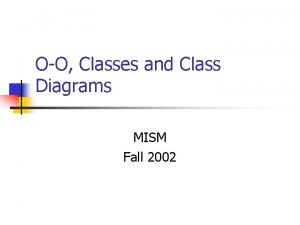







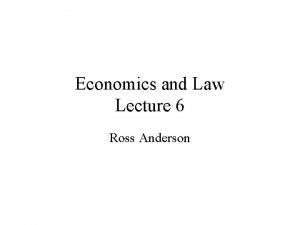
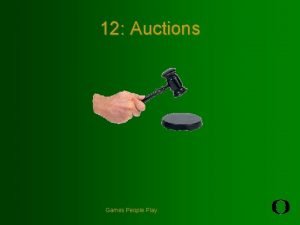
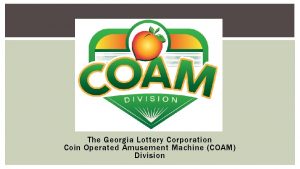
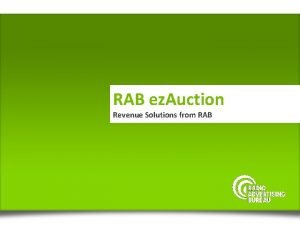

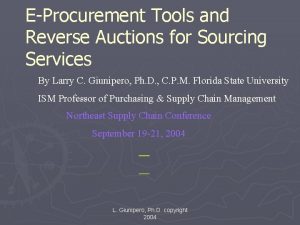
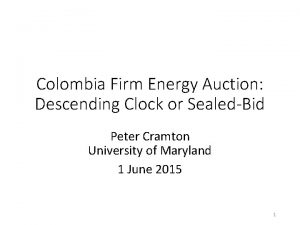
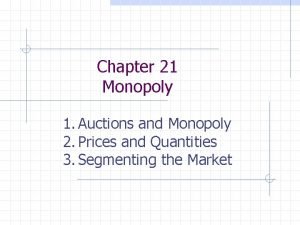


![[ice] inkan auction [ice] inkan auction](https://slidetodoc.com/wp-content/uploads/2021/03/4265618_1c2d54474a1aa46eca42079887e1f0d3-300x225.jpg)
